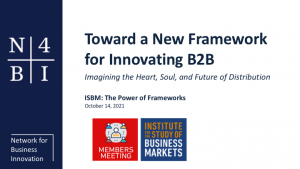
Revolution or Evolution: A Study of the Adoption of AI in New-Product Development
A recent survey of ISBM member firms revealed that AI adoption is poised to grow.
ISBM at the Penn State Smeal College of Business – Academic Institute supporting B2B Research. Switch to the ISBM-Corporate website.

A recent survey of ISBM member firms revealed that AI adoption is poised to grow.

Although they are less widespread than B2C platforms, B2B platforms can succeed by focusing on three key considerations.

Leading companies producing complex and innovative cyber-physical products follow a three-phased process.

The three key components of a customer-obsessed growth engine are creating buyer value, aligning marketing, sales, and product teams, and leveraging technology.

Although short-term projects can generate crucial product and process innovations, their organization requires careful consideration by B2B firms.

Increasing the voice of customer training that market-facing organization members receive can prove a critical precursor to new product organic growth.

Amazon Business is not the future of B2B, or it shouldn’t be. Innovation by B2B for B2B has hit a logjam because existing go-to-market frameworks are not aligned with the opportunities and challenges of the digital age Distribution is a neglected but massively essential B2B asset for established companies. Distribution is drifting towards the future without innovation frameworks that unify the traditional value chain while making room for collaborations with B2B minded platforms. Amazon Business will own the future of B2B if innovators at established companies do not define the future of distribution for themselves. This talk will explore the heart, soul, and future of distribution, with implications for manufacturers, distributors, digital startups, and technology vendors. Presentation from the October 2021 ISBM Members Meeting.

This presentation is from Professor Elham Ghazimatin. Elham is a PhD graduate in marketing from the University of Melbourne, Australia and an assistant professor of marketing at the University of Stavanger (UiS).

As firms face disruptive events in the marketplace, they must be prepared to adapt. Oftentimes, adapting necessitates a “pivot” in how firms operate across multiple dimensions.

As B2B firms increasingly become service-dominant in hopes of building lasting customer relationships, it becomes imperative to determine if the resources and expertise needed to implement B2B service innovations also create increased risk for B2B firms. The differences between customer and business markets find that the impact of service innovations varies across B2B and B2C domains.
© 2024 ISBM – Institute for the Study of Business Markets

484 Business Building
University Park, PA 16802
Phone: 814-863-2782
Fax: 814-863-0413
Email: ISBM@psu.edu
© 2020 ISBM – Institute for the Study of Business Markets